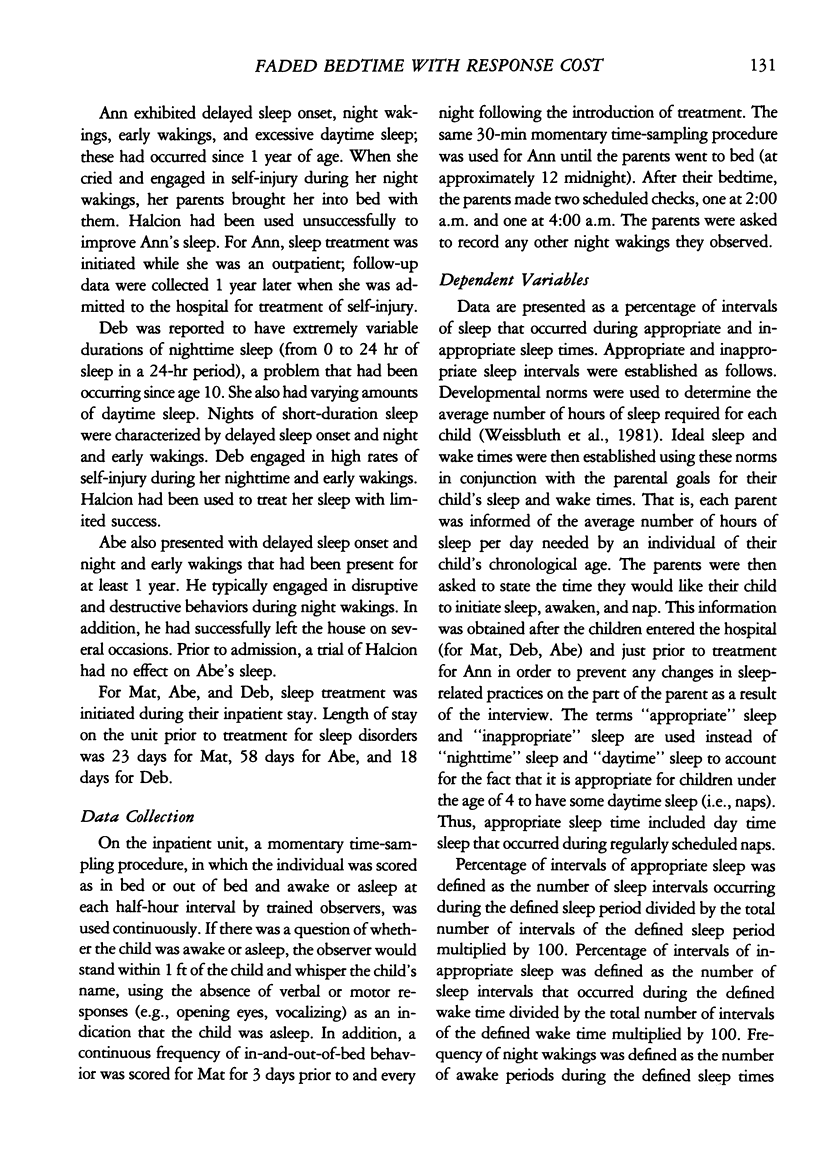Abstract
The sleep-wake cycles of 4 developmentally delayed individuals with longstanding severe sleep disturbances were regulated using a faded bedtime procedure with response cost. Bedtimes were systematically delayed for each individual, thus increasing the probability of short latency to sleep onset. The response cost component, consisting of removing the individual from bed for 1 hour, was implemented when an individual did not experience short latency to sleep onset. A fading procedure was then applied successfully to advance the bedtimes and to gradually increase durations of sleep. Specifically, all 4 individuals had decreased amounts of nighttime sleep that increased following treatment. Two of the 4 individuals showed excessive daytime sleep that decreased following treatment. Three of the 4 individuals experienced decreases in night wakings following treatment. Both environmental and biological manipulations of the sleep-wake cycle are hypothesized as mechanisms of treatment. The relative advantages of this procedure over other procedures for the treatment of pediatric sleep disorders are discussed, as are directions for future research.
Full text
PDF











Selected References
These references are in PubMed. This may not be the complete list of references from this article.
- Adams L. A., Rickert V. I. Reducing bedtime tantrums: comparison between positive routines and graduated extinction. Pediatrics. 1989 Nov;84(5):756–761. [PubMed] [Google Scholar]
- Baer D. M., Wolf M. M. Some still-current dimensions of applied behavior analysis. J Appl Behav Anal. 1987 Winter;20(4):313–327. doi: 10.1901/jaba.1987.20-313. [DOI] [PMC free article] [PubMed] [Google Scholar]
- Borkovec T. D., Grayson J. B., O'Brien G. T., Weerts T. C. Relaxation treatment of pseudoinsomnia and idiopathic insomnia: an electroencephalographic evaluation. J Appl Behav Anal. 1979 Spring;12(1):37–54. doi: 10.1901/jaba.1979.12-37. [DOI] [PMC free article] [PubMed] [Google Scholar]
- Dinges D. F. Differential effects of prior wakefulness and circadian phase on nap sleep. Electroencephalogr Clin Neurophysiol. 1986 Sep;64(3):224–227. doi: 10.1016/0013-4694(86)90170-7. [DOI] [PubMed] [Google Scholar]
- Kataria S., Swanson M. S., Trevathan G. E. Persistence of sleep disturbances in preschool children. J Pediatr. 1987 Apr;110(4):642–646. doi: 10.1016/s0022-3476(87)80571-1. [DOI] [PubMed] [Google Scholar]
- Lozoff B., Wolf A. W., Davis N. S. Sleep problems seen in pediatric practice. Pediatrics. 1985 Mar;75(3):477–483. [PubMed] [Google Scholar]
- Mullaney D. J., Johnson L. C., Naitoh J. P., Friedmann J. K., Globus G. G. Sleep during and after gradual sleep reduction. Psychophysiology. 1977 May;14(3):237–244. doi: 10.1111/j.1469-8986.1977.tb01168.x. [DOI] [PubMed] [Google Scholar]
- Richman N. A community survey of characteristics of one- to two- year-olds with sleep disruptions. J Am Acad Child Psychiatry. 1981 Spring;20(2):281–291. doi: 10.1016/s0002-7138(09)60989-4. [DOI] [PubMed] [Google Scholar]
- Richman N., Douglas J., Hunt H., Lansdown R., Levere R. Behavioural methods in the treatment of sleep disorders--a pilot study. J Child Psychol Psychiatry. 1985 Jul;26(4):581–590. doi: 10.1111/j.1469-7610.1985.tb01642.x. [DOI] [PubMed] [Google Scholar]
- Rickert V. I., Johnson C. M. Reducing nocturnal awakening and crying episodes in infants and young children: a comparison between scheduled awakenings and systematic ignoring. Pediatrics. 1988 Feb;81(2):203–212. [PubMed] [Google Scholar]
- Weissbluth M., Poncher J., Given G., Schwab J., Mervis R., Rosenberg M. Sleep duration and television viewing. J Pediatr. 1981 Sep;99(3):486–488. doi: 10.1016/s0022-3476(81)80357-5. [DOI] [PubMed] [Google Scholar]


